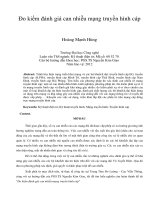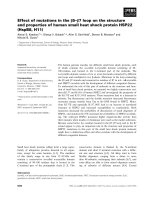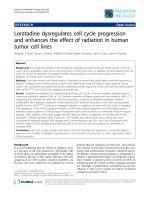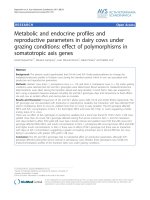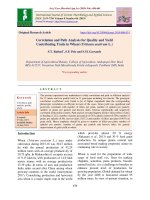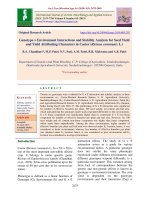Effect of sowing dates and weed control measure on growth and yield of chickpea in Western Rajasthan
Bạn đang xem bản rút gọn của tài liệu. Xem và tải ngay bản đầy đủ của tài liệu tại đây (255.58 KB, 8 trang )
Int.J.Curr.Microbiol.App.Sci (2020) 9(5): 2638-2645
International Journal of Current Microbiology and Applied Sciences
ISSN: 2319-7706 Volume 9 Number 5 (2020)
Journal homepage:
Original Research Article
/>
Effect of Sowing Dates and Weed Control Measure on Growth and
Yield of Chickpea in Western Rajasthan
Mahaveer1, M. L. Reager2 and Shri Rakesh1*
1
Department of Agronomy, Collage of Agriculture, 2Krishi Vigyan Kendra, Swami
Keshwanand Rajasthan Agricultural University, Bikaner, Rajasthan – 334006, India
*Corresponding author
ABSTRACT
Keywords
Crop growth rate,
Relative growth
rate, Pendimethalin,
Quizalofop
Article Info
Accepted:
23 April 2020
Available Online:
10 May 2020
An experiment was carried out during rabi 2015-16 to evaluate growth and yield of chickpea under
different sowing dates and weed control measure. The experiment was laid out in split-plot design
with three replications, assigning twenty treatments consisting of four date of sowing (15 October,
30 October, 15 November and 30 November) as main plot treatments and five weed control measure
(Weedy check, Weed free, Pendimethalin @ 0.75 kg/ha as pre emergence, Imazethapyr @ 20 g/ha at
20 DAS as post emergence and Quizalofop@ 37.5 g/ha at 20 DAS as post emergence) as sub-plots.
Sowing of crop on 15 October remained statistically at par with sowing on 30 October recorded
significantly higher growth parameters viz. plant height, dry matter accumulation, relative growth
rate and yield attributing characters viz. number of branches/plant, number of pods/plant, number of
seeds/pod, test weight, seed yield, straw yield, biological yield, harvest index, net return and B:C
ratio as compared to 15 November and 30 November. In case of weed control measures, weed free
recorded higher growth attributing characters viz. plant height, dry matter accumulation, relative
growth rate and yield attributing characters viz. number of branches/plant, number of pods/plant,
number of seeds/pod, seed yield, straw yield, biological yield, net return and B:C ratio followed by
Pendimethalin @ 0.75 kg/ha as PE and Quizalofop @ 37.5 g/ha as PoE.
Introduction
Chickpea (Cicer arietinum L.) a legume is
popularly known as ―Gram‖ or ―Bengal
gram‖ play an important role in Indian
economy. It belongs to family Leguminoseae
being a rich and cheap source of protein, can
help people to improve the nutritional quality
of their diet. India is the largest acreage
holder and producer of chick pea in the world.
In India, it covers 10.56 million hectares
cultivated area and 11.23 million tonnes an
annual production with productivity of 1063
kg/ha in 2017-18 (GOI, 2018).
In Rajasthan, it is covers 15.97 lakh hectares
area and produced 18.67 lakh tonnes with the
productivity 1169 kg/ha in 2018-19 (GOR
2019). In general, the chickpea is cultivated
on marginal and sub marginal lands under
rainfed conditions as early sown. This early
sown crop results in excessive vegetative
2638
Int.J.Curr.Microbiol.App.Sci (2020) 9(5): 2638-2645
growth, poor setting of pods and greater weed
competition, whereas in double cropping
areas due to cultivation of long duration in
kharif crop varieties, the planting of chickpea
is usually delayed. Under such situation, the
crop has to be sown up to December only.
This late sown crop experiences very low
temperature at initial stages of crop growth
resulting in poor and slow vegetative growth,
whereas the early sown crop allows better
yield
and
growth
improvement
(Mohammadnejad and Soltani, 2005).
Weeds are one of the important factor
responsible for low productivity of chick pea
reduced 30–54 per cent (Mukherjee, 2007)
which is responsible for reducing crop growth
by two mechanism, i.e. completion for
resources and allelopathic effect. In the initial
growth of crop there is relatively shallow
canopy and it slowly shades the inter-row
area, which allows bumper weeds growth and
thus chick pea becomes more susceptible to
weed crop competition. Herbicides are most
effective and economic weed control
measures but always use of herbicides is not
feasible
due
to
some
unavoidable
circumstances like unavailability of proper
herbicides, cropping system requirement and
problem of weed flora shift due to continuous
use of same group of herbicides. Thus, it is
necessity to explore and test other alternative
and economical methods of weed control. The
high cost and non-availability of labour at
right time force the farmers for opting
alternative, cheaper and easier method of
weed control. Several herbicides viz.
pendimethalin, quizalofop and imazethapyr
are presently being used for controlling both
grassy and broad-leaved weeds but their
effects under different climatic conditions are
not well defined. A good weed management
practice with sowing at right time may help in
realizing better yield. Early or delayed sowing
reduces the optimum plant population which
plays an important role in improving the
productivity of crop (Kumar et al., 2003).
With this view field experiments were
conducted to identify the optimum sowing
time, and appropriate weed control measure
for the growth and yield performance in
chickpea.
Materials and Methods
The field experiment was conducted during
rabi season of 2015-16 at Instructional Farm,
College of Agriculture, Swami Keshwanand
Rajasthan Agricultural University, Bikaner,
Rajasthan, India, which is situated at a 28o
01’N latitude and 73o 22’E longitude at an
altitude of 234.70 meters above mean sea
level). The soil of experimental field was
loamy-sand, alkaline in reaction (pH 8.38)
having 89.25 kg/ha available N, low in
available phosphorus (19.5 kg ha-1,) and
medium in available potassium (190.35
kg/ha) in 0-15 cm soil depth at the start of the
experiment. The experiment was laid out in
split-plot design with three replications,
assigning twenty treatments consisting of four
date of sowing (15 October, 30 October, 15
November and 30 November) as main plot
treatments and five weed control measure
(Weedy check, Weed free, Pendimethalin @
0.75 kg/ha as pre emergence, Imazethapyr @
20 g/ha at 20 DAS as post emergence and
Quizalofop@ 37.5 g/ha at 20 DAS as post
emergence) as sub-plots.
The sowing of chick pea variety GNG-1581
using seed rate of 60 kg/ha and maintained
crop geometry 30 × 10 cm was done on
scheduled dates of sowing. The rainfall
received during growing period (October to
April) was 31.3 mm in 04 rainy days. The
mean weekly minimum and maximum
temperature during the crop season fluctuated
from 4.0 to 37.30c with the average relative
humidity from 51.4 to 91.8 %. Experimental
crop was raised as per recommended package
of practices.
2639
Int.J.Curr.Microbiol.App.Sci (2020) 9(5): 2638-2645
The data obtained were statistically analyzed
accord with the Split Plot Design. Analysis of
variance was used to test the significance of
treatment effects at 5 percent level of
probability. Least Significant Difference
(LSD) Test was used to compare treatment
means.
Results and Discussion
Effect of date of sowing
The results revealed that different sowing
dates influences growth parameters like plant
height, periodical dry matter production, crop
growth rate, and relative growth rate, yields
attributing character viz. branches/plant,
pods/plant, seeds/pod, test weight, seed,
straw, biological yield and harvest index
(Table 1 and 2). Sowing date treatments did
not influenced the plant height of chickpea at
30 DAS. However, at harvest, plant height of
chickpea remained statistically at par from 15
October to 30 October. Further delaying the
sowing up to 30 November significantly
decreased the plant height of chickpea. Prasad
(2009) also reported that reduction in plant
height with the delay in sowing time. Dry
matter production of chickpea at 30 and 60
DAS increased significantly, with delaying
date of sowing up to 30 October. However,
dry matter production of chickpea at 90 DAS
and at harvest, 15 October remained
statistically at par with 30 October,
significantly decreased with further delayed
sowing dates up to 30 November. Kumar et
al., (2006) also reported that reduction in dry
matter accumulation and other physiological
parameters with the delay in sowing beyond
October.
Crop growth rate of chickpea were increased
with delaying sowing up to 30 November
(except crop growth rate between 60-90
DAS). Sowing of the crop on 30 November
remained statistically at par with crop sown
on 15 November, recorded the highest crop
growth rate of 0.019, 0.129 and 0.201
g/m2/day between 0-30, 30-60 and 90 DAS to
harvest, respectively, over crop sown on 15
October and 30 October. Relative growth rate
of chickpea between 30 and 60 DAS
increased significantly, with delaying sowing;
however, it was decreased with delaying
sowing between 60 to 90 DAS and 90 DAS to
harvest. Sowing of the crop on 30 November
recorded the highest relative growth rate of
0.65 mg/g/day between 30 to 60 DAS which
was statistically at par with crop sown on 15
November and 30 October, compared to crop
sown on 15 October. However, sowing of the
crop on 15 October, was statistically at par
with crop sown on 30 October, recorded the
highest relative growth rate of 0.93 and 1.21
mg/g/day between 60-90 DAS and 90 DAS to
harvest, respectively, compared to crop sown
on 15 November and 30 November.
Highest number of branches/plant, pods/plant,
seeds/pod, test weight, seed, straw, biological
yield was recorded by crop sown on 15
October which was statistically at par with 30
October over sowing on 15 November and 30
November. The percentage increases in
number of branches/plant (18.49 & 38.12),
number of seeds/pod (16.43 & 41.74), as
compared to crop sown on 15 November and
30 November, respectively. Sowing on 15
October increased pods/plant of chickpea by
12.57, 30.00 and 69.82 per cent over chickpea
sown on 30 October, 15 November and 30
November, respectively. This is completely
agreed with the findings of Rajput et al.,
(1986) who observed higher values of
pods/plant with the early sowing. Sowing on
15 October increased test weight to the tune
of 10.60 per cent over sown on 30 November.
The percentage increases in seed yield (17.69,
& 43.20), straw yield (12.05 & 36.29) and
biological yield (13.99 & 38.67) as compared
to crop sown on 15 November and 30
November, respectively.
2640
Int.J.Curr.Microbiol.App.Sci (2020) 9(5): 2638-2645
The reduction in seed yield under delayed
sowings due to shortening of life span
coupled with lesser biomass production in
chickpea crop had also been reported by Ray
et al., (2011). The sowing on 15 October
enhanced the harvest index of chickpea by
3.25, 3.31 and 3.52 per cent, respectively,
over delay crop sown on 30 October, 15
November and 30 November.
The comparative economics of chick pea is
presented in Table 2. Data of the present
investigation revealed that to raise an
economical crop of Chickpea, optimum
sowing time and proper weed management is
must. Crop sown on 15 October recorded
highest net return (89368 /ha) and B:C ratio
(5.24). Higher harvest index in case of early
sowing might be due to more economic yield
rather than total biomass production. The
findings confirmed the results of Prasad et al.,
(2012).
Effect of weed control measures
Effect of different weed control measures was
also observed on growth parameters like plant
height, periodical dry matter production, crop
growth rate, and relative growth rate, yields
attributing character viz. branches/plant,
pods/plant, seeds/pod, test weight, seed, straw
and biological yield (Table 1 and 2).
Significantly lower values of these parameters
were recorded under weedy check and highest
values of these were recorded in weed free
plot.
Among chemical weed control treatments
highest plant height was observed by
application of pendimethalin @ 0.75 kg/ha as
PE, followed by quizalofop @ 37.5 g/ha.
Arya (2004) also reported higher plant height
in herbicidal treated plots. Application of
weed control measures as pendimethalin @
0.75 kg/ha PE, quizalofop @ 37.5 g/ha as PoE
and imazethapyr 20 g/ha as PoE, respectively,
increased plant height of chickpea by 29.42,
20.30 and 10.38 per cent as compared to
weedy check. Imazethapyr have detrimental
effect on plant height (41.38 cm) of chickpea
which was next lowest. Application of weed
control measures as pendimethalin @ 0.75
kg/ha, quizalofop @ 37.5 g/ha and
imazethapyr @ 20 g/ha, respectively,
increased dry matter production of chickpea
by 33.95, 31.79 and 25.93 per cent at 60
DAS, 35.47, 33.07 and 26.97 per cent at 90
DAS and 29.38, 21.67 and 12.26 per cent at
harvest as compared to weedy check.
Highest crop growth rate 0.142, 0.152 and
0.203 g/m2/day were found in weed free
treatment, further 0.126, 0.136 and 0.166
g/m2/day were recorded in pendimethalin @
0.75 kg/ha, respectively at 60, 90 DAS and at
harvest of chickpea. At 30 DAS crop growth
rate in weedy check remained statistically at
par with weed free and pendimethalin @ 0.75
kg/ha. Highest relative growth rate 0.69, 0.95
and 1.25 mg/g/day were recorded in weed
free treatment, further 0.64, 0.89 and 1.18
mg/g/day were recorded in pendimethalin @
0.75 kg/ha, respectively, between 30-60, 6090 DAS and 90 DAS to harvest of chickpea.
Significantly
higher
number
of
branches/plant, number of pod/plant and
number of seeds/pod was counted under weed
free treatment as compared to all chemical
weed control measures. Both pendimethalin
@ 0.75 kg/ha and quizalofop @ 37.5 g/ha
were at par with each other, produced
significantly higher number of branches/plant,
number of pod/plant and number of seeds/pod
as compared to weedy check and imazethapyr
@ 20 g/ha (Table 2). Application of
pendimethalin @ 0.75 kg/ha and quizalofop
@ 37.5 g/ha, respectively, increased number
of branches/plant (51.25& 48.09 per cent),
number of pods/plant (21.29 & 17.30 per
cent) and number of seeds/pod (24.59 & 23.77
per cent) as compared to weedy check.
2641
Int.J.Curr.Microbiol.App.Sci (2020) 9(5): 2638-2645
Table.1 Effect of sowing date and weed control measures on growth parameters of chick pea
Treatments
Plant height
CGR (g/m2/day)
Dry matter accumulation (g/plant)
RGR (mg/g/day)
(cm)
30
At
0-30
DAS
30-60
DAS
60-90
DAS
90 DASHarvest
30-60
DAS
60-90
DAS
90 DASHarvest
DAS
harvest
15 October
8.78
49.00
0.48
3.48
8.87
16.71
0.016
0.100
0.180
0.121
0.51
0.93
1.21
30 October
8.73
47.91
0.53
4.31
8.77
16.16
0.018
0.126
0.149
0.148
0.64
0.92
1.18
15 November
8.61
44.03
0.56
4.39
7.62
14.65
0.019
0.127
0.108
0.156
0.65
0.86
1.15
30 November
8.18
39.01
0.57
4.43
6.96
12.98
0.019
0.129
0.084
0.201
0.65
0.78
1.09
SEm±
0.26
1.05
0.01
0.13
0.25
0.26
0.0004 0.004
0.011
0.000
0.01
0.01
0.01
CD (P=0.05)
NS
3.65
0.04
0.44
0.87
0.89
0.001
0.015
0.037
0.001
0.05
0.05
0.02
Weedy check
8.68
37.49
0.55
3.24
6.23
12.32
0.018
0.090
0.100
0.143
0.48
0.74
1.07
Weed free
8.71
52.44
0.55
4.82
9.40
18.55
0.018
0.142
0.152
0.203
0.69
0.95
1.25
Pendimethalin @ 0.75
kg ha-1 as PE
Imazethapyr @ 20 g
ha-1 at 20 DAS as PoE
Quizalofop @ 37.5 g
ha-1 at 20 DAS as PoE
SEm±
8.70
48.52
0.57
4.34
8.44
15.94
0.019
0.126
0.136
0.166
0.64
0.89
1.18
8.09
41.38
0.50
4.08
7.91
13.83
0.017
0.120
0.128
0.127
0.62
0.88
1.12
8.70
45.10
0.52
4.27
8.29
14.99
0.017
0.125
0.134
0.144
0.64
0.90
1.15
0.23
1.03
0.01
0.13
0.26
0.26
0.0004 0.004
0.010
0.014
0.01
0.01
0.01
CD (P=0.05)
NS
2.98
0.04
0.37
0.75
0.75
0.001
0.028
0.039
0.04
0.04
0.02
30 DAS
60 DAS
At
90 DAS
harvest
Sowing dates
Weed control measures
DAS = Days after sowing, NS= Non-Significant
2642
0.012
Int.J.Curr.Microbiol.App.Sci (2020) 9(5): 2638-2645
Table.2 Effect of sowing dates and weed control measures on yield attributes, yield, harvest index and economics of chick pea
Treatments
Yield attributes
Branches/
plant
Yield (kg/ha)
Pods/
plant
Seeds/
pod
Test
weight
(g)
Seed
Straw
Bio
logical
Harvest
index
(%)
Economics
Net
returns
( /ha)
B:C
ratio
Sowing dates
15 October
6.92
30.72
1.63
144.4
1734.9
3142.0
4877.0
35.60
89368
5.24
30 October
6.42
27.29
1.57
143.1
1625.6
3089.4
4715.0
34.48
82683
4.88
15 November
5.84
23.63
1.40
139.4
1474.1
2804.1
4278.3
34.46
73026
4.43
30 November
5.01
18.09
1.15
130.6
1211.6
2305.3
3516.9
34.39
56275
3.62
SEm±
0.16
0.98
0.05
2.24
42.4
80.1
122.5
0.07
2706
-
CD (P=0.05)
0.54
3.38
0.16
7.76
146.7
277.1
423.9
0.23
9366
-
Varieties
Weedy check
5.26
18.07
1.22
136.4
1055.7
1968.9
3024.6
34.78
48369
3.55
Weed free
7.06
31.48
1.70
143.0
1945.2
3654.4
5599.7
34.73
99419
5.04
Pendimethalin
@
0.75 kg ha-1 as PE
Imazethapyr @ 20
g ha-1 at 20 DAS as
PoE
Quizalofop @ 37.5 g
ha-1 at 20 DAS as
PoE
SEm±
6.38
27.33
1.52
137.7
1628.9
3061.3
4690.2
34.72
82964
4.97
5.36
21.03
1.25
140.2
1328.7
2482.7
3811.5
34.82
64639
4.22
6.17
26.76
1.51
139.73
1599.1
3008.7
4607.9
34.60
81300
4.93
0.16
0.91
0.05
2.61
42.9
81.6
124.6
0.07
2740
-
CD (P=0.05)
0.47
2.62
0.14
NS
123.7
235.1
358.9
NS
7892
-
2643
Int.J.Curr.Microbiol.App.Sci (2020) 9(5): 2638-2645
Weed free treatment produced significantly
higher seed, straw and biological yield over
rest of all chemical weed control treatments
and weedy check. Chemical weed control
treatments such as quizalofop @ 37.5 g/ha
and pendimethalin @ 0.75 kg/ha being
statistically at par with each other, produced
significantly higher seed, straw and biological
yield over imazethapyr @ 20 g/ha.
The percentage increases in seed yield (54.29,
25.86, & 51.47), straw yield (55.48, 26.10, &
52.81) and biological yield (55.06, 26.02, &
52.34) by pendimethalin @ 0.75 kg/ha,
imazethapyr @ 20 g/ha and quizalofop @
37.5 g/ha over weedy check, respectively.
Weed free gave the highest net return (99419
/ha) and B:C ratio (5.04) over weedy check
followed by Pendimethalin @ 0.75 kg/ha as
PE (82694 /ha) and B:C ratio (4.97).
The crop sown on 15 to 30 October overall
better than other dates of sowing it was
recorded significantly higher growth and yield
potential. Pendimethalin @ 0.75 kg/ha as PE
was most effective in influencing growth and
development and increasing yield of chick
pea.
Acknowledgments
The authors would like to thank to
Department of Agronomy, College of
Agriculture, Swami Keshwanand Rajasthan
Agricultural University for facility support.
References
Arya,
R.L.
2004.
Integrated
weed
management in chickpea (Cicer
arietinum) + mustard (Brassica juncea)
intercropping system under rainfed
conditions.
Indian Journal of
Agronomy. 49(2): 98-100.
Chaudhary, B. M., Patel, J.J. and Delvadio,
D.R. 2005. Effect of weed management
practices and seed rates in weeds and
yield of chickpea. Indian Journal of
Weed Science, 37:271–272.
GOI (2018) Agricultural Statistics at a Glance
2018, Ministry of agriculture & Farmers
Welfare Department of agriculture,
cooperation & Farmers Welfare
Directorate of Economics & Statistics
New Delh : 96.
GOR (2019) Directorate of agriculture, Pant
krishi Bhawan, Jaipur, Rajasthan –
302005.www.dorgovraj.in
Kumar, M., Singh, R.C., Kumar, R. and
Singh, S. 2003. Effect of date of sowing
and row spacing on performance of
chickpea genotype. Haryana Journal of
Agronomy, 19(2):140–141
Kumar, S. Kumar, M. and Kadian V.S., 2006.
Biomass partitioning and growth of
chickpea (Cicer arietinum L.) as
influenced by sowing dates and
genotypes. Legume Research, 29(2):
110-113.
Mohammadnejad, Y. and Soltani, A. 2005.
Shares of main stem and branches in
determining grain yield of chickpea
with different planting dates and
densities. In proceeding of the First
National Conference on Pulse in Iran
20–21 Nov. 2005.
Mukherjee, D. 2007. Techniques of weed
management inchickpea—a review.
Agriculture Review, 28(1): 34–41.
Prasad, D. Bhan, C. Sharma, V and Prasad,
H., 2012. Effect of various plant
geometry on chickpea (Cicer arietinum)
under different dates of sowing: Journal
of Progressive Agriculyure, 3: (2): 1216
Prasad, D. 2009. Effect of different plant
population on chickpea genotypes under
late sown conditions. M.Sc. Thesis,
CCSHAU, Hisar.
Rajput, R. L., Shrivastava, U. K. and Yadav,
R. P., 1986. Response of chickpea to
sowing
dates.
Indian
Journal
2644
Int.J.Curr.Microbiol.App.Sci (2020) 9(5): 2638-2645
Agronomy, 31(1): 95-96.
Ray, M., Nanda, M. K. and Khan, D. K.
2011. Effect of date of sowing and
irrigation on seed yield, yield attributes
and water use of Chickpea (Cicer
arietinum L.) at lower Gange tic plains
of West Bengal. Journal of Crop and
Weed, 7(2): 30-32.
How to cite this article:
Mahaveer, M. L. Reager and Shri Rakesh. 2020. Effect of Sowing Dates and Weed Control
Measure
on
Growth
and
Yield
of
Chickpea
in
Western
Rajasthan.
Int.J.Curr.Microbiol.App.Sci. 9(05): 2638-2645. doi: />
2645
